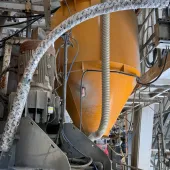Production restarts at CEMEX South Ferriby

Cement plant fires up again 12 months after devastating flood brought operations to a standstill
PRODUCTION has recommenced at CEMEX UK’s South Ferriby cement plant, following the severe flooding that brought the plant to a standstill in December 2013.
Just over a year ago high tides, strong winds and low atmospheric pressure resulted in the river Humber breaching flood defences and deluging the cement plant and surrounding community with water up to 2m deep.
This week, after significant work by the plant’s 150-strong workforce and more than 400 contractors during the past 12 months, one of the two cement kilns has been commissioned and is once again producing high-quality clinker for cement making.
One of the challenges facing CEMEX since the flooding has been in meeting their obligations to fulfil customers’ orders. To this end, cement has been supplied out of the company’s Tilbury and Rugby plants.
Over the last 12 months considerable work has gone into the plant not only to reinstate production, but also to establish a production plant of the future.
‘South Ferriby plant had grown organically through the site for the last 80 years,’ commented plant director Philip Baynes-Clarke. ‘The flood gave us the opportunity to rebuild it in a logical way to today’s standards with tomorrow’s production in mind.’
Two other key challenges immediately after the flood were to secure and clean the site, and to establish welfare facilities for the small army of people who would be needed to rebuild the plant. Some 160 portacabins were secured, some from as far away as Scotland, to provide accommodation for administration, laboratories, canteen and welfare facilities.
When the flood swept through the site it cut off the 11,000V electrical supply and destroyed 30 switch rooms and two substations. Today, more than 6.4km of high-voltage cables have been laid to supply the various operations throughout the site. These now lead to one electrical substation, which houses modern electrical switchgear.
In addition, the 30 switch rooms have been rebuilt together with the vast majority of the site’s electrical systems. Efficiencies, such as LED lighting, have been built in to the new systems to provide savings in electricity.
With the failure of the electric supply when the flood hit, one of the kilns stopped in mid-production with hot material still in it, causing the kiln shell to bend due to the high thermal load. Months of work have been spent replacing a 22m section of the 65m long kiln.
All elements of the cement production process are now controlled from a centralized computer providing immediate response and allowing for improved optimization. This new state-of-the-art control system replaces five control rooms which are all marked for demolition in the coming months.
Mr Baynes-Clarke commented: ‘Hundreds of thousands of parts have been replaced with expertise from colleagues and specialist companies from around the world. CEMEX colleagues from the plant have worked tirelessly and the last year has been a learning curve for everyone, with new systems and procedures to adopt.
‘Rebuilding the plant in 12 months has been no mean feat and I am immensely proud of what we have achieved. The refurbished plant will allow us to continue our heritage of producing quality cement, sustainably, safely and efficiently, now and for many years to come.’









